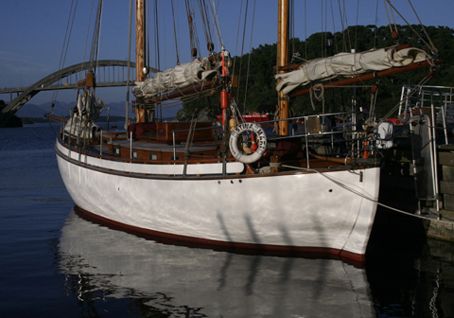
One of the most common questions we get regarding marine varnish is what kind of finish is best for a mast. Even though aluminum has long since replaced Sitka spruce as the material of choice for a sailboat mast, there is no shortage of boats that still have wooden masts. Many of the Taiwanese-built boats of the 70s and 80s had wooden masts, and of course, a wide range of U.S.-built classics still have their original wooden masts.
In a recent PS Advisor, we laid out some options for refinishing a mast and tried to explain why we are not big fans of sealing wood with epoxy. Here’s the gist of that report:
While epoxy seems like a logical choice for keeping moisture at bay and dealing with abrasion from halyards, theres more to this question than simply finding a material with good adhesion and a durable, abrasion-resistant bright finish.
Soft woods see a lot of moisture-induced surface movement, so coatings must be able to cope with the physical surface changes linked to dry, hot weather and the wet, cooler times of the year. That is why many people prefer relatively flexible spar varnishes for such applications. Although theyre less durable-from an abrasion-resistance perspective-than hard coatings like epoxy, they do give the wood that elegant amber look.
Epoxy resin is the vice grip of all coating materials, but it has poor handling characteristics (flow, leveling, brushability) and no UV inhibitors. Mas Epoxies, however, are less viscous than most epoxies and tend to penetrate the substrates surface, making their flow out a little easier to control.
Using any epoxy as a base for an attractive wood finish is tricky. For one thing, its hard to sand without burning through, which will cause noticeable color changes when the topcoat is applied. And when the surface does fail, 85 percent of it will still be solidly stuck to the soft wood, and its removal or repair will be a major pain.
In our opinion, coating a mast with epoxy prior to varnishing and then topping off with a two-part coating is asking for more work down the road. The epoxys best attribute, its adhesive tenacity, is also its bane.
We recommend sticking with a good spar varnish, or following the Awlgrip approach that the pros use: Apply a few coats of Awlgrips Awlspar, an amber-hued phenolic tung-oil varnish, and then overcoat with Alwgrip Awlbrite, a two-part, clear acrylic urethane (www.awlgrip.com). Both can be found online; a quart of Awlspar costs about $30, but the Awlbrite comes with a hefty $70-per-quart pricetag.
If you opt for a different spar varnish, check out our series on exterior-wood finishes to find out what will work best for you.
Practical Sailor subscribers can see results of our long-term test of varnishes and other wood finishes in the May 2009, January 2011, and September 2011 issues. Our initial reports on one-part varnishes and two-part varnishes that appeared the August 2007 and December 2007 issues are available to all sailors, as is our January 2011 guide to selecting varnish types and December 2009 guide to maintaining varnish. To search our complete archives for past reports on varnishes and clear wood coatings, search under wood coatings, wood finish, or specific product names like Cetol.
































